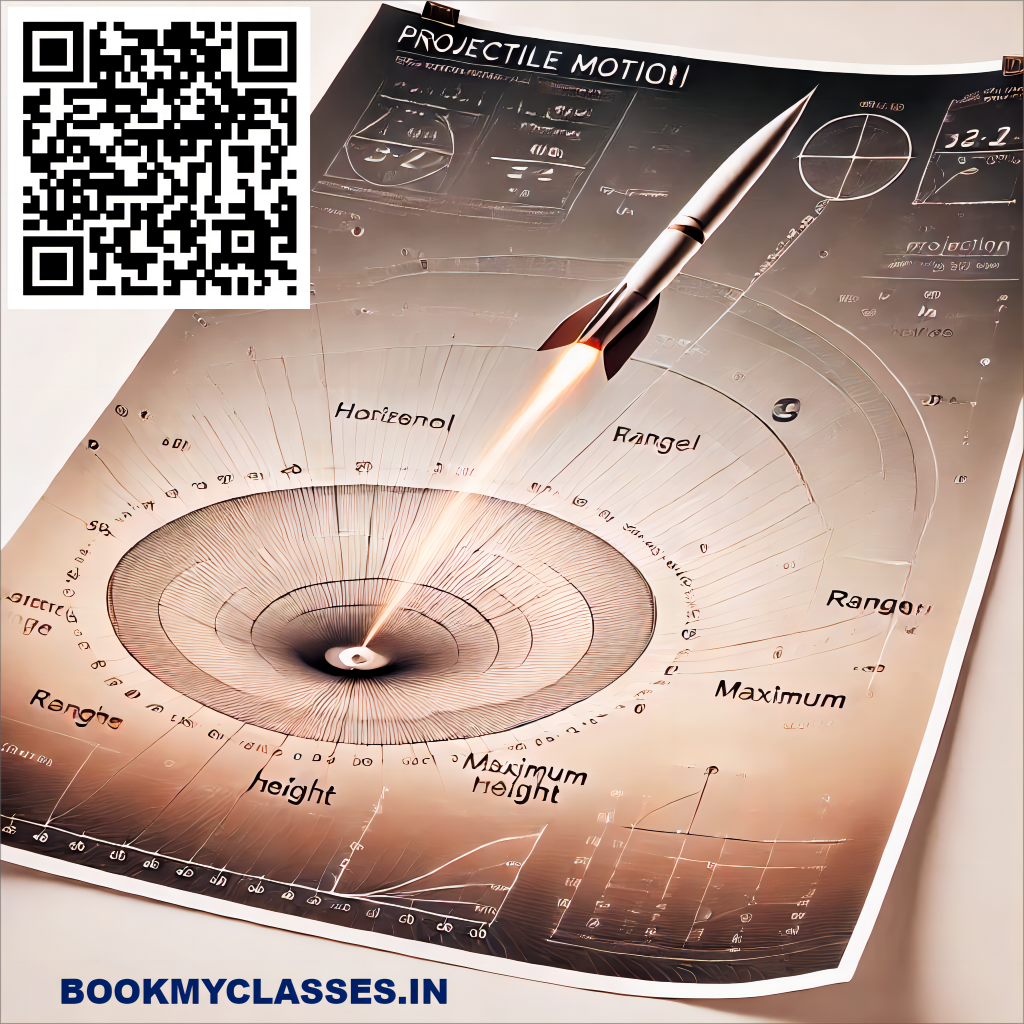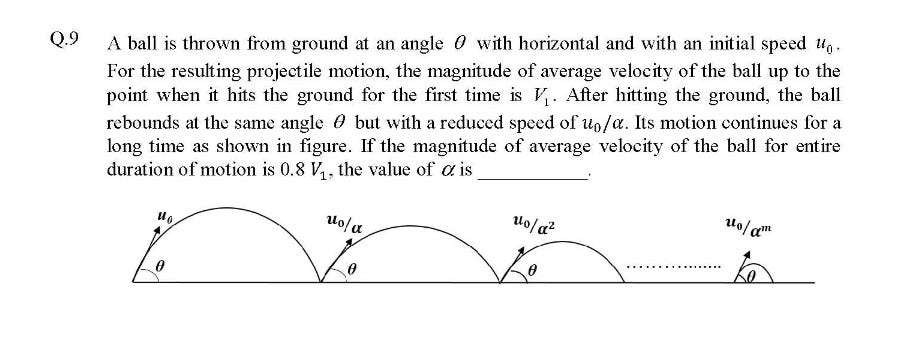How to solve Projectile Motion Questions -Step by Step Guide
With solved examples and one JEE Advanced Question solved
For assistance in Physics WhatsApp us using the QR Code BELOW
How to Solve Projectile Motion Problems Smartly -NEET, JEE & other Entrance Exams
Projectile motion is a fundamental concept in physics that deals with objects launched into the air under the influence of gravity. While the math can seem intimidating at first, there are smart strategies to simplify the process and solve problems efficiently. Here’s a step-by-step guide to mastering projectile motion problems.
1. Understand the Basics
Before diving into problems, ensure you understand these key concepts:
A projectile moves in two dimensions: horizontal (‘x’) and vertical (‘y’).
The motion is governed by two independent equations:
Horizontal motion: x=vx X t
Vertical motion: y=(vy x t−1/2 g t^2)
The acceleration in the horizontal direction is zero, while the vertical acceleration is due to gravity g=9.8 m/s^2
Key terms to know: initial velocity (v0, angle of projection (θ), time of flight (T), maximum height (H), and range (R).
2. Break Down the Problem
Smart problem-solving begins with organization:
Step 1: Read the problem carefully and identify what is given and what is required.
Step 2: Sketch a diagram of the scenario to visualize the motion and its components.
Step 3: Split the initial velocity (v0) into its horizontal and vertical components:
vx=v0 cosθ
vy=v0 sinθ
3. Use the Right Equations
Projectile motion problems typically fall into one of three categories:
a. Finding Time of Flight (T):
Use the vertical motion equation: T=(2vy)/g=(2v0sinθ)/g
For cases where the projectile lands at a different height ( i.e. the projectile falls below or above the level from where it was projected), solve the quadratic equation derived from y=vy x t−1/2 g t^2
b. Finding Maximum Height (H):
Use the vertical velocity equation at the highest point (vy=0 ): H=(v0 sinθ)^2/(2g)
c. Finding Horizontal Range (R):
The total horizontal distance is: R= vx multiplied by T = {v0^2 sin(2θ)}/g
4. Use Symmetry in Motion
Projectile motion is symmetric around the highest point. This means:
The time to reach maximum height is half the total time of flight:
The upward and downward journeys take equal time.
Use symmetry to quickly identify heights and velocities at corresponding points.
Examples of Using Symmetry
Time Symmetry: If the total time of flight of a projectile is , the time to reach the highest point is . For example, if a ball is in the air for 4 seconds, it takes 2 seconds to reach the peak.
Velocity Symmetry: The vertical velocity at any point during the descent matches the vertical velocity at the same height during the ascent, but in the opposite direction. For instance, if the vertical velocity at a height on the way up is , then on the way down at the same height, it is .
Displacement Symmetry: The total vertical displacement over the full flight is zero if the projectile lands back at the same height from which it was launched. This simplifies calculations of average velocity and trajectory.
Range Symmetry: For a given initial speed, the range of a projectile is the same for complementary angles of projection (e.g., 30 and 60 ). This is because the horizontal displacement depends on sin (2θ). Both angles yield the same range, but the trajectories differ:
At , the projectile has a lower maximum height and a flatter trajectory.
At , the projectile reaches a higher maximum height but spends more time in the air.
5 ."Projectile Motion: When the Landing Point is Above or Below the Point of Projection"
In projectile motion, when a projectile lands at a height different from its starting point, the vertical displacement (y) is not zero. The equations of motion need to be adapted to account for this difference in height.
Key Adjustments:
Vertical Motion Equation: The general equation for vertical motion is:
y=v0sinθ⋅t−1/2 g t^2,,
where y is the vertical displacement:
Positive y indicates landing above the initial point of projection.
Negative y indicates landing below the initial point of projection.
Time of Flight: To find the total time of flight, solve the quadratic equation for t:
1/2 g t^2−v0 sinθ⋅t -y=0 Use the quadratic formula:
Horizontal Range: Once the total time of flight T is determined, calculate the horizontal range using: R= (v0cosθ) T.
6. Common Tips for Smart Problem Solving
Tip 1: Identify which part of the motion is relevant. For instance, if the question only involves horizontal displacement, focus on x= vx X t (multiplication)
Tip 2: Eliminate unnecessary variables. Often, you can solve for time or velocity without needing all parameters.
Tip 3: Memorize key formulas but understand their derivations for flexibility.
Tip 4: Keep units consistent (e.g., convert velocities to m/s and distances to meters).
Tip 5: If stuck, write down all known values and equations —this often reveals the path to the solution.
7 Maximum Range Situation in Projectile Motion
In projectile motion, the maximum range is achieved when the angle of projection is optimized. Here's a detailed look at the concept:
Key Concept
The horizontal range (R) of a projectile is given by:
R={v0^2 sin(2θ)}/(g),
where:
v0 is the initial velocity of the projectile,
θ is the angle of projection,
g is the acceleration due to gravity.
The range depends on the sine of 2θ, which reaches its maximum value when 2θ=90. Thus, the angle of projection for maximum range is:
θ=45∘
Maximum Range Formula
Substituting sin(90∘)=1 into the range equation:
Rmax=(v0^2)/ g.
This represents the greatest possible horizontal distance a projectile can travel for a given initial velocity.
8. Practice Smartly
The best way to master projectile motion is through practice. Start with simple problems (e.g., horizontal launches) and gradually move to complex ones (e.g., angled launches or varying heights). Identify patterns in solutions, and always verify your answers by checking dimensions and logic.
Example Problem 1
Question: A ball is launched with a speed of 20 m/s at an angle of 30 DEGREES. Find the time of flight, maximum height, and horizontal range.
Solution:
Split into components: vx=20 cos30∘≈17.3 Vy= 20 sin30 = 10m/s
Time of Flight: T=2vy/g=2×109.8≈2.04 s
Maximum Height: H=(vy) 22g=1022×9.8≈5.1 m
Horizontal Range: R=vxT=17.32×2.04≈35.3 m
Example Problem 2
Using Symmetry in Motion:
Question: A projectile is launched at a speed of 15 m/s at an angle of 45∘. Find the time to reach the maximum height and the total time of flight. Verify the symmetry of motion.
Solution:
Split into components: vx=15 cos45∘≈10.6 m/s, vy = 15 sin 45=10.6 m/s
Time to Reach Maximum Height: The time to reach the peak is given by: tup=vy/g=10.6/ 9.8≈1.08 s
Total Time of Flight: The total time of flight is twice the time to reach maximum height: T=2 tup=2×1.08≈2.16 s
Symmetry Check: The projectile takes the same amount of time to go up as it does to come down. Thus, tup=tdown, confirming symmetry in motion.
Example Problem 3
Analyzing Damped Projectile Motion with Average Velocity
Question: A ball is thrown from the ground at an angle θ with horizontal and with an initial speed u0. For the resulting projectile motion, the magnitude of average velocity of the ball up to the point when it hits the ground for the first time is v1. After hitting the ground, the ball rebounds at the same angle θ but with a reduced speed of u0/α. Its motion continues for a long time as shown in the figure. If the magnitude of the average velocity of the ball for the entire duration of motion is 0.8 v1, find the value of α.
Solution:
Step 1: Average velocity for one flight: The average velocity for one flight is:
v1= (Total displacement / Total time of flight)
For one flight:
Total horizontal displacement = R={u0^2 sin(2θ)}/g
Total time of flight = T={(2u0sinθ)}/g
Therefore:
v1 (average velocity) =R/ T={(u0^2)sin(2θ)/g}/{(2u0 sinθ)}/g}={(u0)/(2 cos(θ)}
Step 2: Analyze multiple rebounds:
The ball rebounds with a reduced speed of u0/α, u0/α^2 and so on.
The total displacement in the horizontal direction forms a geometric series: Rtotal=R (1+1/α+1/α^2+… )
Step 3: Average velocity for infinite motion: The total time of motion also forms a geometric series:
Ttotal= T(1+1/α+1/α^2+… )…………..= R α / ( α-1)
Thus, the average velocity for infinite motion is:
Vavg = Rtotal / Ttotal=R/T
Step 4: Relating average velocities: Given vavg=0.8 v1 substitute:
0.8v1=(v1)/(α-1)
Simplify to find α
0.8(α−1)=1 ⟹ α=5.
Final Answer: α=5
Example Problem 4- See the Video Below
Example 5: Projectile Landing Below the Initial Point
Question: A ball is projected with an initial velocity of 20 m/s at an angle of 30∘. It lands 5 m below the point of projection. Find the time of flight and the horizontal range.
Solution:
Vertical Motion Equation: Substituting into the equation for vertical motion:
−5=20 sin30∘⋅t−1/2⋅9.8⋅t^2.
Simplify:
−5=10t−4.9t^2. (QUADRATIC IN t)
Rearrange:
4.9 t^2−10t−5=0
Solve for t: Use the quadratic formula:
t=−(−10)± SQRT {(−10)2−4 (4.9) (−5)} / {2(4.9)}
Simplify:
t=10± sqrt (100+98) / 9.8
Approximate SQRT 198≈14.07
t=10±14.079.8. .
Choose the positive root:
t=10+14.079.8≈2.45 s.
Horizontal Range: Use R=v0 cosθ⋅T
Final Answer:
Time of flight: 2.45 s
Horizontal range: 42.4 m
Would you like this added directly to the blog document?
Conclusion
Projectile motion problems become manageable with the right approach and plenty of practice. Focus on breaking the problem into components, applying the correct equations, and leveraging symmetry. With time, solving these problems will feel intuitive and straightforward. Happy learning!




